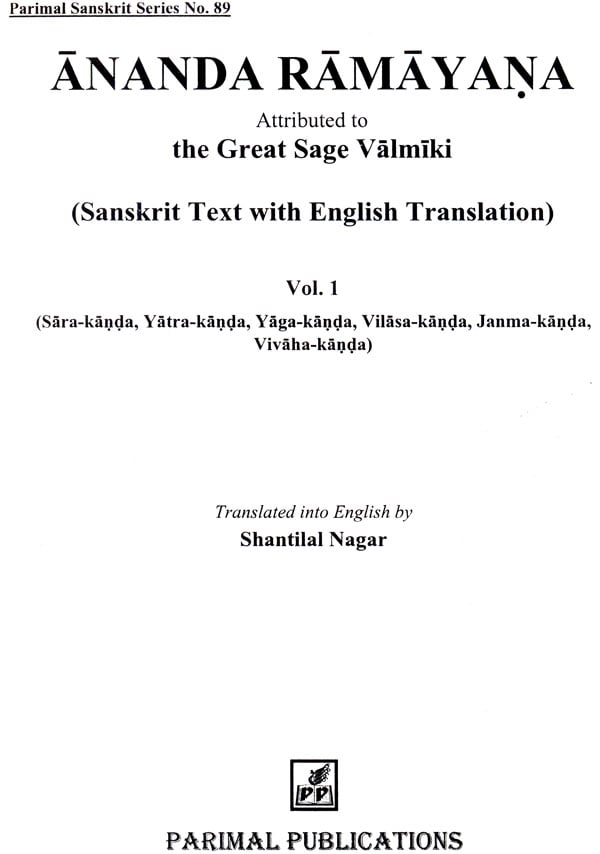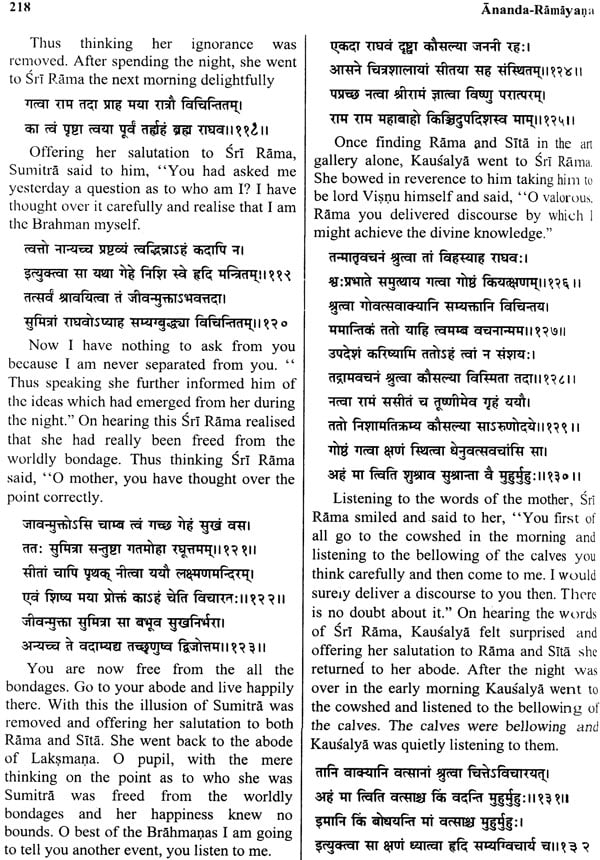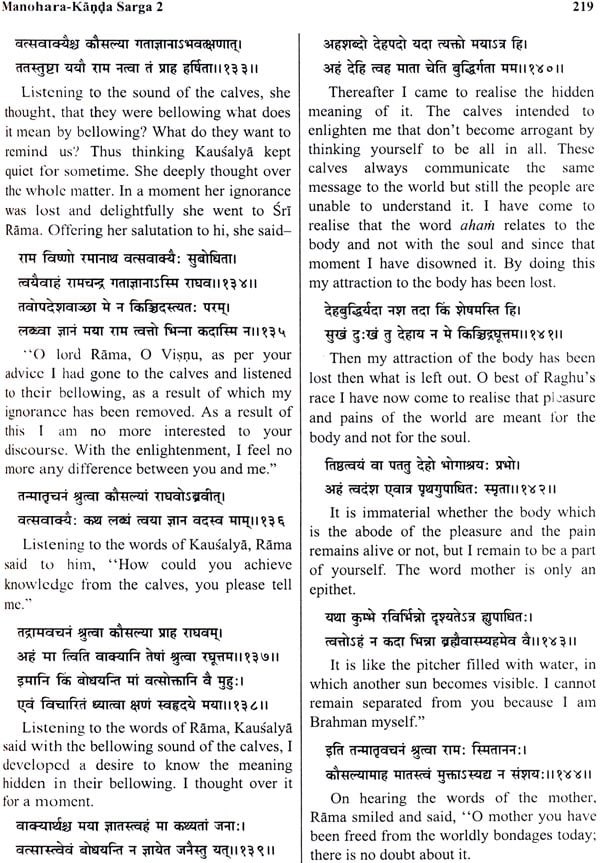
ANANDA RAMAYANA: Attributed to The Great Sage Valmiki (2 Volumes)
Book Specification
| Item Code: | IDF389 |
| Author: | Translated into English by Shanti Lal Nagar |
| Publisher: | Parimal Publication Pvt. Ltd. |
| Language: | Sanskrit Text, English Translation and an Introduction: Two Volumes |
| Edition: | 2006 |
| ISBN: | 9788171102822 |
| Pages: | 972 |
| Cover: | Hardcover |
| Other Details | 9.6" X 7.5" |
| Weight | 2 kg |
Book Description

With the composition of the Ramayana by the sage Valmiki, there was a boost in the popularity of the story of Rama. The life of Rama had been quite ideal and his life stories had been quite popular with the masses, possibly in fragments in earlier times but Valmiki did a great service to the country by composing the Ramayana which happens to be the earliest poetic excellence besides being quite unique and unparallel.
Various Ramayanas in Sanskrit like the Adhyatma, Mantra, Adbhuta and Ananda Ramayana were also composed. In the Ananda Ramayana several events of later period have been included which could never appear to have been composed by Valmiki at all. There is a tradition that the Ananda Ramayana was composed by some one in the fourteenth century or so by a great poet, which appears to be acceptable by and large.
One of the most interesting aspect of this Ramayana is the inclusion of the episode of abduction of Kausalya by Ravana which stands included in the first Sarga of the Sara-kanda. Further, this Ramayana portraits iconographical features of Rama and his brothers, describes about birth of Sita, Ravana carrying Parvati , skill of Hanuman etc.. This Ramayana also has the unique coverage highlighting the Ramaraksa-stotras, a thousand name of Rama and the formation of several types of Ramabhadra and Ramalingatobhadras, besides Rama, Sita and the other kavacas.
The entire translation of the present edition has been divided into 10 Kandas, starting with the Sara-kanda and ending with the Purna-kanda. This is the first time that an English translation has been done of this excellent Ramayana in Sanskrit. The translator has done a great labour to attempt an authentic translation of Ananda Ramayana.
Ever since the dawn of civilization on earth, man has been wandering here and there in search of protection from the natural, man-made, visible and invisible forces. He had been sometimes successful in his efforts and sometimes not. Evidently the forces of nature attracted him most and he was more attracted towards the sun, the moon and the rains, the water and greenery. But soon he learnt of domesticating the animals and with that his requirements multiplied and so was the case with the dangers from several causes and anxiety to ward them off. This could be the reason why the Vedic literature considered to be the earliest treatises of the country, initially emphasised invoking of the forces of nature for seeking various types of favours. With the developing of the farming the needs of the people were multiplied and so were their problems in which the nature again played a forceful role. Still the people at large invoked these forces of nature like the sun, the moon, Indra, Varuna, Rudra, Kala, Usas and several other gods to rid themselves of a varied types of dangers.
Soon -the Vedic deities were personified and started being adored in human form instead of in abstract forms as in the early Vedic age. The post - Vedic literature massively, contributed towards the personification of these deities. Not only were these gods personified but their forms met with change with the passage of time. For example, Vedic Rudra was later conceived as Siva, Prajapati as Brahma and Visnu, who was not so powerful a Vedic god, was conceived as a mighty all pervading god having four arms in the post-Vedic literature. Gradually the iconography of these gods was slowly developed but by about the Puranic times when various attributes were also prescribed for them in the sitting or standing postures.
Of all the Vedic gods, Visnu happened to be the only one who was conceived to incarnate on earth quite often in order to rid the earth of her burden and for the destruction of the evil as well as for the upliftment of the noble people. The Puranas are quite vocal about the various incarnations of Visnu. Though the Puranas differ on the exact number of incarnations of Visnu but by and large, the ten incarnations of Visnu are widely accepted by different texts.
The incarnations of Rama happens to be the seventh in the series and has been most popular with the people besides that of Krsna who followed Rama. The life of Rama had been quite ideal and his life stories had been quite popular with the masses, possibly in fragments in earlier times but Valmiki did a great service to the country by composing the Ramayana which happens to be the earliest poetic excellence besides being quite unique and unparallel.
With the composition of the Ramayana by the sage Valmlki, there was a boost in the popularity of the story of Rama. Of course, Valmlki composed his work on the basis of the brief of the story provided to him by Narada at the instance of Brahma, but evidently he himself collected the scattered fragments of Rama's story, so abundantly available in every nook and corner of the country, but still he could not incorporate in his work all of them. As an instant, it may be pointed out that the tribals of Bastar and other tribal areas in Madhya Pradesh, have their own versions of the Ramayana story which in many ways differ from the story of the sage Valmlki.
Soon the tendency of bringing out the Ramayana in regional languages gained momentum, particularly in the medieval times and several such works in Hindi, Bengali, Oriya, Tamil, Telugu, Kannada, Malayalam and several other languages were brought out. In spite of the Ramayana works in the regional languages, the Sanskrit poets did not neglect the theme altogether. Indeed several Sanskrit poets like Bharavi, Kumaradasa, Bhavabhuti, Bhasa, Kalidasa and others did pay special attention to the story and incorporated the same in their works in some form or the other.
| VOLUME - 1 (1)Sara-kanda | ||
| Sarga-1 | The marriage of Dasaratha and Kausalya and performing of Putresahi yajna by Rsyasrnga. | 1 |
| Sarga-2 | Birth of Rama, Lakshmana, Bharata and Satrughna. | 9 |
| Sarga-3 | The killing of Tadaka, redemption of Ahalya and Sita's Svayamvara. | 12 |
| Sarga-4 | Rama's battle with enemy kings and the curse of Vrnda to Visnu. | 41 |
| Sarga-5 | Redemption of Kalaha by Dharmadatta. | 53 |
| Sarga-6 | Entry if Rama in the Dandaka forest. | 63 |
| Sarga-7 | Killing of Viradha and Khara, Dusana by Rama. | 73 |
| Sarga-8 | Friendship between Rama and Sugriva besides killing of Vali. | 86 |
| Sarga-9 | Hanuman arrives in Lanka in search of Sita and burning of Lanka. | 95 |
| Sarga-10 | Battle between armies of Rama and Ravana. | 120 |
| Sarga-11 | Killing of Ravana at the hands of Rama. | 141 |
| Sarga-12 | Crowning of Sri Rama. | 163 |
| Sarga-13 | Conversation between Agastya and Rama. | 178 |
| | ||
| Sarga-1 | The story relating to the creation of Ramayana. | 194 |
| Sarga-2 | Composing of Ramayana by Valmiki. | 197 |
| Sarga-3 | Rama commands the messengers to reach the confluence of Ganga and Sarayu | 204 |
| Sarga-4 | Rama divides Sarayu river into two parts | 210 |
| Sarga-5 | The story of Kumbhodhara. | 218 |
| Sarga-6 | Pilgrimage of eastern countries. | 224 |
| Sarga-7 | Sri Rama's pilgrimage of the south. | 234 |
| Sarga-8 | Rama's pilgrimage to the western region. | 241 |
| Sarga-9 | Pilgrimage of Sri Rama to the northern region of the country and his return to Ayodhya. | 244 |
| | ||
| Sarga-1 | Collection of the material for the performing of the yajna | 251 |
| Sarga-2 | Rama's advice to Laksmana to remain cautious at the time of the performing of yajna. | 255 |
| Sarga-3 | Return of the sacrificial horse of Rama to Ayodhya after roaming about everywhere. | 260 |
| Sarga-4 | Rama's meeting with the Sage Kumbhodhara. | 264 |
| Sarga-5 | Ramasatanamastotra. | 269 |
| Sarga-6 | Daily routine of Sri Rama. | 274 |
| Sarga-7 | Glory of hoisting of flag. | 278 |
| Sarga-8 | Description of purification bath after the performing of yajna. | 283 |
| Sarga-9 | Completion of Asvamedha-yajna. | 290 |
| | ||
| Sarga-1 | Ramastotra recited by Siva. | 298 |
| Sarga-2 | Description of beauty of Sita by Sri Rama. | 305 |
| Sarga-3 | Description of Deha-Ramayana by Rama as questioned by Sita. | 311 |
| Sarga-4 | Description of the various ornaments of Sita. | 317 |
| Sarga-5 | Water sports of Sita. | 324 |
| Sarga-6 | Daily routine of Sri Rama and Sita. | 329 |
| Sarga-7 | Blessing of Rama to the damsels of the heaven. | 333 |
| Sarga-8 | Anger of Sita over Rama because of the concubine Pingala. | 335 |
| Sarga-9 | Visit of Sri Rama at Kuruksetra on the eve of the solar eclipse. | 345 |
| | ||
| Sarga-1 | Rama's visit to the orchard. | 350 |
| Sarga-2 | Sri Rama and Sita roam about in the orchard. | 355 |
| Sarga-3 | Rama disowns Sita. | 359 |
| Sarga-4 | Birth of Lava-Kusa in the asrama of Valmiki. | 366 |
| Sarga-5 | Ramraksa Mahamantra. | 372 |
| Sarga-6 | Lava brings the lotus flowers for his mother from Ayodhya. | 377 |
| Sarga-7 | Battle of Rama and Laksmana with Lava and Kusa. | 382 |
| Sarga-8 | Rama accepts Sita again. | 392 |
| Sarga-9 | The yajnopavita ceremony of the children of Sri Rama and others. | 399 |
| | ||
| Sarga-1 | Rama's visits to the kingdom of Bhurikirti in connection with svayamvara. | 411 |
| Sarga-2 | Svayamvara of Campika the daughter of the king Bhurikirti. | 415 |
| Sarga-3 | Svayamvara of Sumati the second princess. | 422 |
| Sarga-4 | Description of the marriage of Lava and Kusa. | 428 |
| Sarga-5 | Sri Rama frees Gandharvas and Naga damsels from the clutches of the water goddesses. | 432 |
| Sarga-6 | The girls of Gandharvas and the serpents were to be married to the sons of Laksmana. | 435 |
| Sarga-7 | The marriage of the daughters of Gandharvas and the serpents. | 439 |
| Sarga-8 | Kidnapping of the Madansundari by Satrughna and Yupaketu. | 342 |
| Sarga-9 | Expansion of the race of Sri Rama. | 449 |
| | ||
| | ||
| | ||
| Sarga-1 | Ramasahasranamastora | 1 |
| Sarga-2 | Reason for bringing Kalpavrksa and Parijata on earth. | 15 |
| Sarga-3 | The sweet conversation between the devotees of Rama and Krisha. | 20 |
| Sarga-4 | Rama bestows boon on hundred damsels and the story of Mulakasura. | 30 |
| Sarga-5 | Separation of Rama and Sita. | 41 |
| Sarga-6 | Distribution of the kingdom by Rama. | 46 |
| Sarga-7 | Victory of Sri Rama over Bharatavarsa. | 55 |
| Sarga-8 | Victory of Sri Rama over Jambudvipa. | 59 |
| Sarga-9 | Victory of Sri Rama over Plaksadvipa and other six islands. | 64 |
| Sarga-10 | Punishment by Rama to a Sanyasi, Sudra and the vulture. | 71 |
| Sarga-11 | Sri Rama grants a boon to four Brahmana girls. | 81 |
| Sarga-12 | Sri Rama grants boon to sixteen thousand damsels and four other women including Kalindi. | 87 |
| | ||
| Sarga-13 | Rama bans laughing in his kingdom. | 97 |
| Sarga-14 | The story of birth of Valmiki and appraisement of mantras. | 107 |
| Sarga-15 | Rama and the qualities of Ramarajya. | 119 |
| Sarga-16 | Rama's advice to Lava, Kusa and his brothers on polity. | 126 |
| Sarga-17 | Svayamvara of Hema, the daughter of Kusa. | 134 |
| Sarga-18 | Rama donates Ramanathapuram to the Brahmanas. | 142 |
| Sarga-19 | Rama's daily routine. | 149 |
| Sarga-20 | Incarnations of the lord. 159 | |
| Sarga-21 | Rama appears in two forms while blessing his slaves. | 168 |
| Sarga-22 | Sita joins the fallen leaf of Tulasi plant. | 175 |
| Sarga-23 | The glory of Ananda Ramayana. | 183 |
| Sarga-24 | Rama's advice to Yama, Sumantra's departure for Vaikunaha and Rama's advice to his people. | 188 |
| | ||
| Sarga-1 | Ramayana in brief. | 200 |
| Sarga-2 | Proceeding of Kausalya and other mothers to Vaikunaha. | 209 |
| Sarga-3 | Development of the adoration of Rama. | 220 |
| Sarga-4 | Expension of Laghuramatobhadra | 239 |
| Sarga-5 | The method of creation of Ramalingatobhadra and other lingatobhadras. | 264 |
| Sarga-6-a | Consecration of the gods in Ramatobhadra and the glory of Ramanavami. | 294 |
| Sarga-6-b | The story of Ramanavami. | 298 |
| Sarga-7 | The method of writing the name of Rama and the method of completing it. | 315 |
| Sarga-8 | Merit for reciting of Vedas and other scriptures. | 326 |
| Sarga-9 | Special adoration of Sri Rama. | 336 |
| Sarga-10 | The glory of spending the month of Caitra in Ayodhya. | 351 |
| Sarga-11 | The glory of Caitra-snan. | 364 |
| Sarga-12 | Advaita philosophy as propounded by Sri Rama. | 386 |
| Sarga-13 | Hanuman-kavaca and Rama-kavaca. | 393 |
| Sarga-14 | Description of Sita-kavaca. 404 | |
| Sarga-15 | Kavacas of Laksmana, Bharata and Satrughna. | 412 |
| Sarga-16 | Consecration of Hanuman's flag. | 429 |
| Sarga-17 | Brief of Ramayana as spoken by Sri Rama. | 434 |
| Sarga-18 | Hanuman breaks arrow bridge made by Arjuna. | 444 |
| | ||
| Sarga-1 | The expension of the story of lunar race. | 449 |
| Sarga-2 | Departure of Rama to fight battle with the rulers of the lunar race. | 453 |
| Sarga-3 | Rama's fight with the rulers of lunar race. | 460 |
| Sarga-4 | Friendship between the rulers of solar and lunar races. | 464 |
| Sarga-5 | Rama bids farewell to friends and other kings. | 469 |
| Sarga-6 | Rama's proceeding to Vaikuntha. | 473 |
| Sarga-7 | Description of solar race. | 478 |
| Sarga-8 | Chornology of the Ananda Ramayana. | 481 |
| Sarga-9 | The Merit of Listening to the Ananda Ramayana. | 486 |


 to all international destinations within 3 to 5 days, fully insured.
to all international destinations within 3 to 5 days, fully insured.




